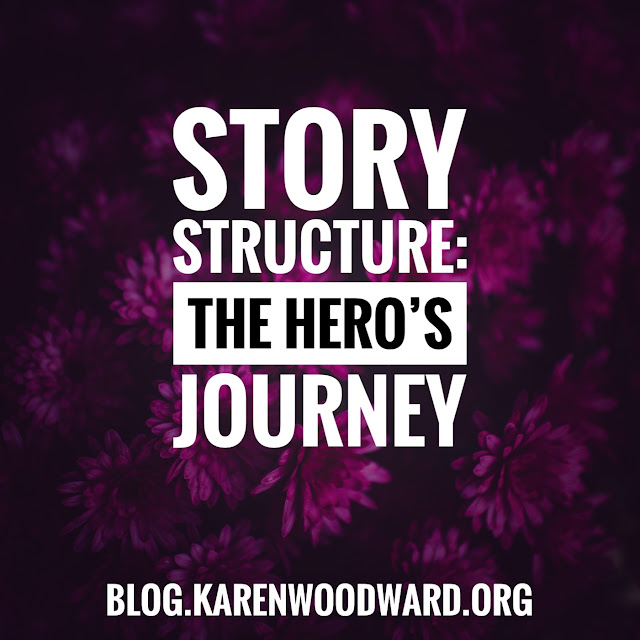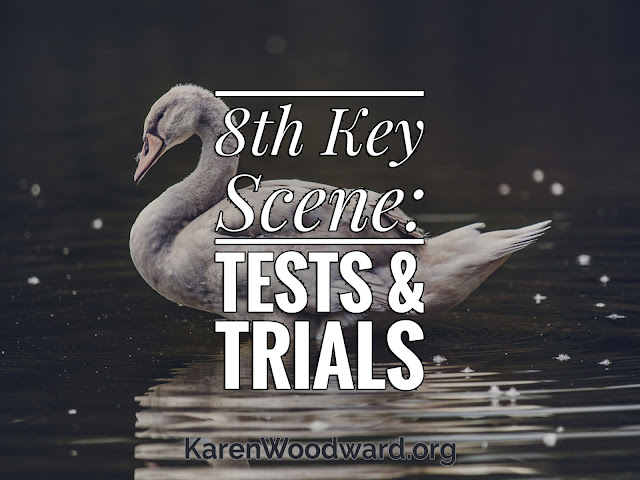The Hero's Journey
Over the years I've written quite a bit about story structure. So much in fact that I resolved not to do another post about it for a while! But then I began writing my NaNoWriMo novel and a few more things fell into place.
I would really like to know what you think of it. Do you agree? Disagree? Is there anything you would add?
A few random comments before we get started
I believe that, with few exceptions, each genre story is a version of the hero's journey. The specifics are different but the general progression is more-or-less the same.
Not all points, below, will be in every story. For example, sometimes the Inciting Incident and The Call to Adventure will occur at the same time.
Also, sometimes the hero doesn't reject The Call to Adventure.
Another way this structure can vary occurs at the Midpoint. Occasionally the important change to The Hero's life is that he receives information about the story world. Other times the important change comes about because of a physical confrontation between the Big Bad and The Hero. Sometimes (for instance, in a romance) the change occurs when the lovers (the protagonist and antagonist) take their physical relationship to the next level.
About the Midpoint ...
I talk more about this below but, for me, the essential thing about the Midpoint is a revelation the hero has, one that comes about because the Big Bad gives (either directly or indirectly) The Hero some information that makes him view the story world in a fundamentally different way. For example, Cage in the movie Edge of Tomorrow realizes that he is a better fighter than his teacher, who happens to be the woman he is in love with. He realizes he has a choice between saving her life and saving the world. He chooses the world and in so doing, he transitions from cowardice to courage.
Because of what happens at the midpoint, because of the The Hero's sacrifice and resulting growth, The Hero's becomes a threat to the Big Bad.
The Hero has an inner and outer goal. At the beginning of the Midpoint the hero hasn't yet made a lot of progress toward his inner goal. As a result, the hero isn't much of a threat to the Big Bad.
At the Midpoint Cage accepts that he will have to give up the person he loves the most in order to save the world. That moment of sacrifice marks a fundamental transition, reorientation, in The Hero's hierarchy of values. It is BECAUSE the hero makes this sacrifice that he becomes a true danger to the Big Bad. Now -- if I may use this expression -- the hero is in it to win it. He is committed. It doesn't matter if he survives as long as he wins.
At the second Pinch Point the hero comes into conflict with the Big Bad. Because The Hero went through a fundamental restructuring at around the Midpoint, he survives the confrontation, and now the Big Bad is concerned. He realizes that now The Hero is a threat. This sets things up for the hero's race for the finish and the climax of the story.
In what follows please take the percentages with a grain of salt, it's the order that matters. Also, I've done all calculations assuming at finished length of 75,000 words.
Act One
1. Inciting Incident (1% -- 750)
An event that changes the nature of the Ordinary World. It is a disaster that divides the time before from the time after.
2. Call to Adventure (10% -- 7,500)
Because of the Inciting Incident, because of the way it has changed the world, the hero is asked to take on a dangerous challenge for the good of both himself and his community.
Note: The call to Adventure and the Inciting Incident can occur within the same scene.
3. Refusal of the Call (12% -- 9,000)
The hero isn’t a hero yet and the Adventure that he is being asked to undertake is dangerous. The hero doesn’t think he’s up to the task, he’s never done anything even remotely like this before! Besides, the hero has so many responsibilities, he just can’t leave. Maybe next year.
4. Disaster (16% -- 12,500)
An event occurs, something connected to how the Inciting Incident changed the story world, that divests the hero of many of his responsibilities. This event pushes the hero into the adventure and then burns his bridges so there's no going back.
For example, In Star Wars IV: A New Hope Luke said he couldn’t go with Obi Wan because he couldn’t leave his Aunt and Uncle; he was duty bound to help them run their farm. Then disaster hit. Stormtroopers killed Luke's Aunt and Uncle and burned their farm to the ground. Not only did this relieve Luke of his responsibilities but he was given a new motivation to take on the adventure Obi Wan offered: revenge.
5. Acceptance of the Call (20% -- 15,000)
The hero accepts the challenge being offered, usually by a mentor, to save both himself and his community. He does this even though he realizes that he is ill equipped for the task.
Act Two
6. Cross the threshold (25% -- 18,750)
The hero crosses over from the Ordinary World -- the world he’s used to -- to the Special World of the Adventure. Usually there is a journey involved. The Special World is very different from the Ordinary World and the hero has no idea how to act. His strengths are now weaknesses and perhaps at least one of his weaknesses is now a strength. The hero needs friends and allies to help him succeed in this strange new world.
The Hero will also make new enemies.
7. Tests and Trials (30% -- 22,500)
The hero is tested and found wanting (often this is played for laughs). The hero trains and gets better. Sometimes there is a series of scenes and sequels that ends in a minor competition that demonstrates the hero's progress.
8. The First Pinch Point (37% -- 27,750)
Since entering the Special World the hero has become sidetracked. He has been busy learning about the Special World and how to succeed in it. Now the hero's external goal becomes his primary focus.
It is here that the hero gets his first glimpse of the power of the Big Bad. At this point the hero has made some progress toward his external goal but not a lot of progress toward his internal goal. This means that the hero is not yet a strong threat to the Big Bad. Sometimes this attack is just the Big Bad playing with the hero like a cat with an injured mouse.
9. The Plan (42% -- 31,500)
The hero and his allies get together and make a plan to defeat the Big Bad. Often all The Hero's allies are present, there is eating and drinking, so this scene often takes place in a bar or great hall.
This is a lighter scene, perhaps there is a good natured argument. The allies bond.
Perhaps the hero has an ally that we think may be a traitor. This would be a good place to explore that.
10. The Approach (46% -- 34,500)
The Hero and his allies travel to the place of conflict.
11. The Midpoint Confrontation (50% -- 37,000)
Often, the hero confronts the Big Bad at the midpoint. The hero wins in the sense that he doesn’t get killed and escapes, but in all other ways he loses. As a result of his confrontation the Big Bad, either directly or indirectly, the hero is given a crucial piece of information. Something the hero thought was indisputably true about the Special World turns out to be false. Further, his attempt to defeat the Big Bad relied on this idea/thought/piece of information being true.
There isn't always a confrontation between the hero and the Big Bad at the midpoint. Occasionally The Hero confronts the Big Bad's minions, or sometimes -- if, for example, the Big Bad wants to recruit the hero -- they call a truce and talk. Occasionally the Big Bad calls a truce to get the hero out of the way so his minions can attack the hero's allies.
At some point after the First Pinch Point, and no later than the Midpoint, the hero makes significant progress toward his inner goal. This growth is usually in response to a significant failure or loss. For instance, in The Edge of Tomorrow Cage is presented with a choice: save the woman you love or save the world. He chooses the world -- Cage would never have done that at the beginning.
12. Escape (60% -- 45,000)
The hero escapes by the skin of his teeth. He reunites with his allies and tells them what he’s found out.
13. The Second Pinch Point (62% -- 46,500)
The hero gets his second experience of the full power of the Big Bad. This is the most powerful attack he and his allies have faced.
At this point the Big Bad is actually worried about the hero. Because of the progress he has made on his inner goal he has actually become dangerous. Here the Big Bad throws everything he has at The Hero in an effort to take him out.
14. The Plan (70% -- 52,500)
Because of the savage attack by the Big Bad, the hero and his allies realize they have to defeat him and now there is a ticking clock. It has to be done SOON.
Even though it is practically impossible to kill the Big Bad, if the hero is to save his friends, his community, the world and possibly the galaxy, he must confront the Big Bad and he must win. So the hero and his allies make a plan.
Note that the plan doesn’t have to be complicated. The hero’s sidekick could turn to the hero and ask, “So, what’s the plan?” The hero turns to her and says, “Don’t die.”
Act Three
After this point no new characters are introduced.
15. The Approach (75% -- 56,250)
The hero implements The Plan. Usually the hero has to travel to where the confrontation with the Big Bad will take place. At the end of the approach, there may be a confrontation between the hero’s sidekick and the Big Bad’s sidekick.
The Hero's Flaw
The Hero needs to face his inner flaw head-on. We want to expose his true nature. Perhaps, up until this point, The Hero has denied the existence of the inner flaw but now he admits it to himself and, as a result, becomes stronger. Strong enough to take on this nearly impossible task.
The Choice
Often The Hero is offered a choice by the Big Bad. He will have to decide between abandoning his outer/external goal (e.g., finding the ark, recovering the magical gem, etc.) and the life of someone he loves.
Often The Hero will abandon his external goal -- or at least make accomplishing it a LOT less likely -- to save the person he loves. But not always. For example, Cage in Edge of Tomorrow was given this choice at the Midpoint and he gave up the person he loved.
The key here is that The Hero will choose to do the right thing, the courageous thing, at great personal cost.
In making this choice, The Hero should burn all his bridges. He is committed to whatever course of action he has decided on.
Ticking Clock
The Hero is often given a set period of time in which to decide which sacrifice he will make. In this way The Choice also sets up a ticking-clock which helps to increase suspense. Also, there should be some chance, however slight, that The Hero won't have to actually make The Choice.
16. All Hope is Lost (85% -- 63,750)
This is the lowest point in the story. It seems as though the hero has failed completely. There is no coming back from this. There is no more hope.
This is where the progress The Hero has made on his inner goal often becomes crucially important. If he were the same person who Accepted the Call in Act One, this setback, this disaster, would finish him off. But he's NOT the same person. He has grown. And because of this all hope is NOT lost.
Make this moment last, don't rush over it. This is where The Hero's true nature is revealed. (By the way, this point is from Deborah Chester.)
This is the final point of growth for The Hero. This is a bit like his death and resurrection. Here he lets go of everything he has been hanging on to, everything that has kept him from changing into the kind of person his community needs him to be, and becomes someone who can change the world.
17. The Climax (92% -- 69,000)
It seems as though The Hero has lost. As Deborah Chester writes:
"Although in the dark moment, the protagonist seems defeated ... and although the protagonist has sacrificed a goal -- the thing he thought he wanted most -- instead of his conscience or his principles .... and although the story question appears to be answered with a no ... and although the antagonist seems to have won ... that's not the way the story's going to end." (Deborah Chester, The Fantasy Fiction Formula)
The hero confronts the Big Bad.
Generally there will be at least three try-fail cycles and the hero will come to a point where it looks like The Hero has lost. But The Hero has grown because of his journey, because he accepted The Call to Adventure. He has become stronger.
Because he has changed The Hero is able to defy all the odds and win.
You might wonder, Well, okay, but exactly HOW does The Hero win? After all, it really looks as though the poor guy is finished.
Right. That is the tricky bit. Often writers call back to something cleverly planted earlier in the story. Perhaps two or three things that, when taken together and with a bit of luck will allow The Hero to do something exceptionally spectacular. And of course it doesn't hurt that the Big Bad is absolutely sure The Hero is finished and no longer a threat.
A couple of things to note: However The Hero ends up succeeding, it has to be from The Hero's own efforts. It's not that no one else can help him -- sometimes the Big Bad's abused Sidekick gives The Hero some help -- but the solution must come from The Hero.
Here's the message of this kind of story: If we take on challenges we will grow and become better than we are and, as a result of this growth, we could have a better life and be an asset to a community with which we are deeply connected. That’s why readers love these kind of stories, they echo a deeper truth.
At least, that’s my take on it! I’d be interested in knowing what you think.
18. The wrap-up (99% -- 74,250)
The Wrap-Up is crucial. It is perhaps the most important part of the book. Readers need to see the stakes being cashed out. How did the hero’s win affect his allies? His friends? His community? The world? How did his win affect his enemies and their communities?
The Wrap-Up can be very brief -- a couple of paragraphs. I try to keep it to under 1000 words. That said, some writers use an entire chapter for her Wrap-Up ... and it works!
Well, that's it! I'd love to hear what you think about this outline, especially if you disagree.
What I'm reading:
Right now I'm reading Midnight Riot by Ben Aaronovitch which is the first book in his Rivers of London series. What book(s) is on your bedside table?
If you would like to support my blog ...
Every post I pick something I love and recommend it. This serves two purposes. I want to share what I’ve loved with you, and, if you click the link and buy anything over at Amazon within the next 24 hours, Amazon puts a few cents in my tip jar at no cost to you. So, if you click the link, thank you! If not, that’s okay too. I’m thrilled and honored you’ve visited my blog and read my post.
Today I’m recommending Blue Moon by Lee Child. I haven't read this one yet, but it's at the top of my "to-read" list. Here is an excerpt:
"The city looked small on a map of America. It was just a tiny polite dot, near a red threadlike road that ran across an otherwise empty half inch of paper. But up close and on the ground it had half a million people."





